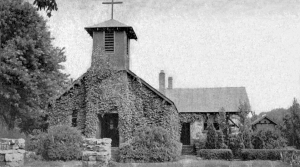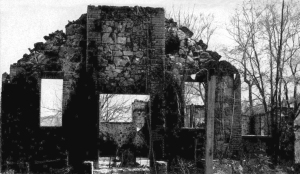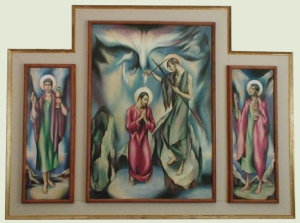| |
 |
| |
Epiphany
Mission, 1938 |
| |
|
 |
estled in a scenic
valley of the southern Cumberland Mountains of Tennessee in the
small community of
Sherwood sits Epiphany Mission Episcopal Church.
From its humble beginning, Epiphany Mission would grow to be much
more than just a place of worship.
In the late 1800's, two Episcopal missionary women came to Sherwood
to provide schooling for the children. They asked Rev. William S.
Claiborne, later Archdeacon of Tennessee, to hold a service for the
community. On Christmas Day, 1898, a service was held in the public
school building, and Epiphany Mission was born. A wood frame church
was built in 1902 and later replaced by a sandstone structure in
1928.
After being ordained, a teacher at St. Andrew's School in nearby
Sewanee asked to be allowed to serve at Epiphany Mission as a
full-time priest. But the diocese of Tennessee, in the early days of
the depression, could not supply money for the mission. The priest
was allowed to go to Sherwood, unaided by the diocese, provided he
could find support elsewhere. In 1932, Epiphany Mission received its
first priest-in-charge, Father George W. Jones.
To support the Mission and its work, Father Jones enlisted the aid
of what he affectionately called “The Greater Congregation”.
Composed of individuals that lived beyond the valley all across the
country, The Greater Congregation were friends and benefactors to
the Mission providing money and “boxes” (boxes of cloths, shoes,
books, and other items that could be used by the needy as well as
the church). Also in 1932, Father Jones began publishing The
Booklet, a report of the Mission activities and the needs of the
people that it served.
The Mission Distribution Center, affectionately known as
“Flossie’s”, was established for the distribution of clothes and
goods donated by The Greater Congregation. The Mission House was
established for parochial purposes, but also included a library that
could be used by the community. St. David’s Gym, a gymnasium used as
a recreation center for the people of Sherwood, was built in 1947.
And in 1954, a clinic was built to provide medical services to the
people of the valley.
|
 |
|
|
"Our Lady of
the Hills Chapel" in the Mission Garden, c 1940s |
|
| |
|
But it was in 1938 that the building of the Mission Garden began.
Built by the boys of the mission (including the casting of the
blocks and bricks) over the course of several years, it would become
a 16,000 square foot walled garden complete with pools, fountains,
bricked walkways, and an open‑air chapel. The boys built the garden
and then the youths became the gardeners tending to the garden day
to day. The garden was also a way to occupy idle time and to provide
needed income (although the pay was small).
The centerpiece of the garden was the open-air chapel where Mass was
sometimes held during the summer. The chapel had an altar and a
large statue of Mary holding the infant Lord and would become known
as “Our Lady of the Hills Chapel”. People from across the country
would visit the little stone church and its walled garden.
In 1950, Father Jones was named “First Citizen” of Sherwood and was
selected to represent the community at the celebration for the
presentation of the badge from the World War II British destroyer
HMS Sherwood – presented as a token of good will between England and
this country.
For twenty years Father Jones guided the Mission until his death in
1952. After his death, Father Joseph S. Huske became the
priest-in-charge and would lead the Mission for the next fifteen
years.
In 1953 an accomplished abstract artist from Nashville visited
Epiphany Mission and was so taken with the Mission and its work that
he wanted to paint a new altarpiece for the chapel – a gift. Philip
Perkins painted a triptych for the new altarpiece depicting the
Baptism of Christ. On Easter, 1954, the triptych was presented to
the church.
| |
 |
| |
The ruins of
Epiphany Mission
following a fire in 1960. |
| |
|
Life in Sherwood was never easy and many of those living in the
valley lived in extreme poverty. Sherwood would endure the
Depression years and then the Second World War only to fall victim
to a lack of employment that would cause an exodus of most of the
people in search of work. But Epiphany Mission faced its greatest
challenge in 1960. On the Wednesday after Easter, an early morning
fire destroyed the church. Everything was lost. Using the Phoenix as
its symbol for resurrection, Epiphany Mission would be rebuilt by
1967.
Following the construction of the new church, Father Huske left
Epiphany Mission in 1967. Father Rodman Pattee Kirby would become
the new Mission priest and would remain at Epiphany Mission for
twenty-seven years, until his death in 1994.
With the passing of Father Kirby, Epiphany Mission would see one of
its own return to lead the church. The Rev. Lucy Lee Shetters, a
native of Sherwood, became Vicar at Epiphany Mission in 1994 and
still guides the church today.
As the population of Sherwood dwindled, so did the membership at
Epiphany Mission. With few members left, the Mission Garden could
not be maintained and much of it has been lost. But Epiphany Mission
is still active today and like the Phoenix, the Mission has begun
anew and is growing. On June 20th, 1999, Epiphany Mission celebrated
its Centennial.
 |
|
|
The Study
for the Epiphany Mission Triptych,
c 1953, by Philip Perkins. |
|
In 1953/54 while working on the triptych for Epiphany Mission,
Philip Perkins had painted a half-size study. On Easter, 2001,
forty-seven years after the original was presented to the church,
the Study for the Epiphany Mission Triptych was presented to
Epiphany Mission in Philip Perkins' memory.
A member of the church who remembers the old stone church and the
original triptych has said, “In the fire we lost everything, our
church, the mementos, the memories. It's as if a part of our past is
coming back to us.”
— Dan
Hardison |



